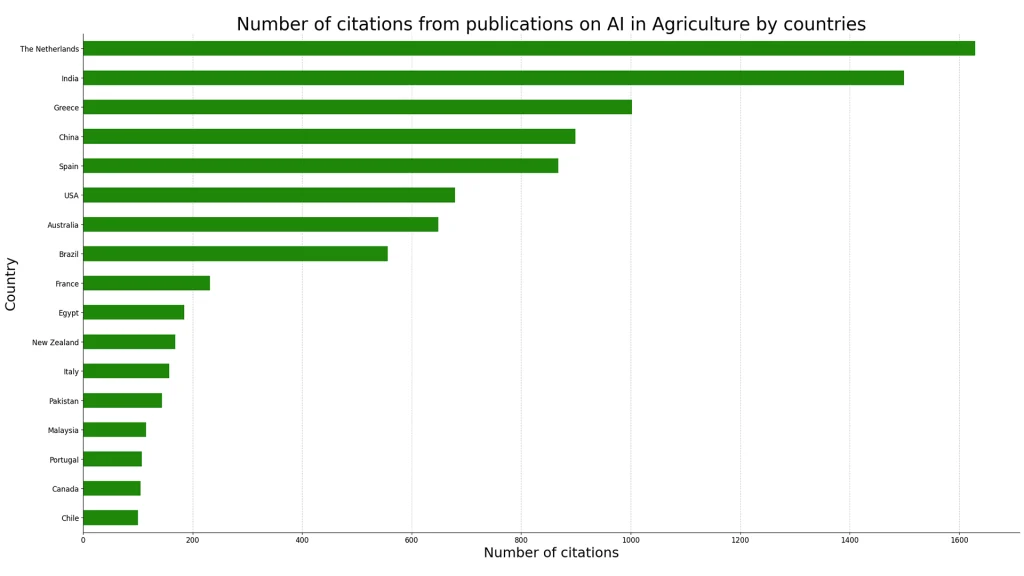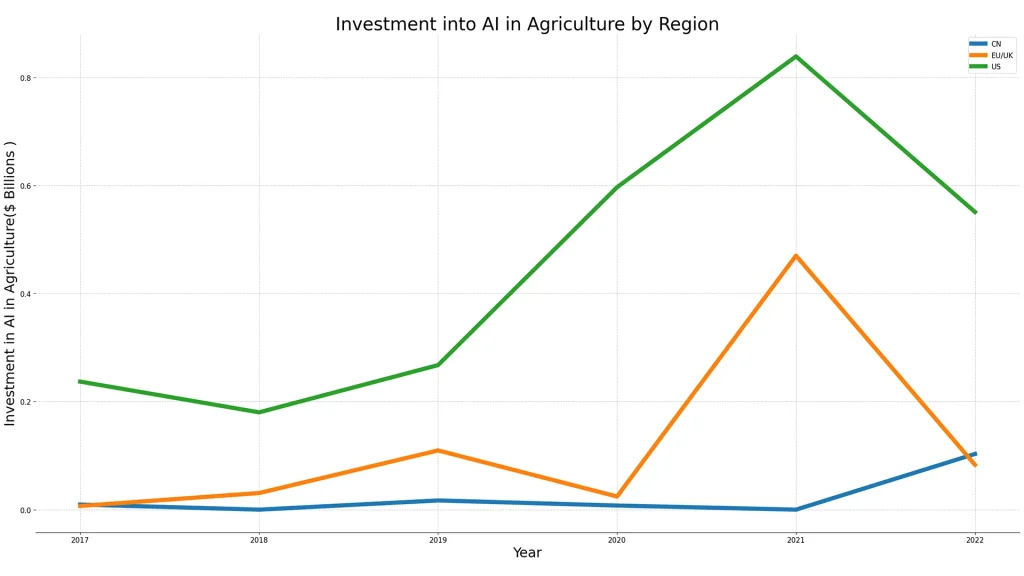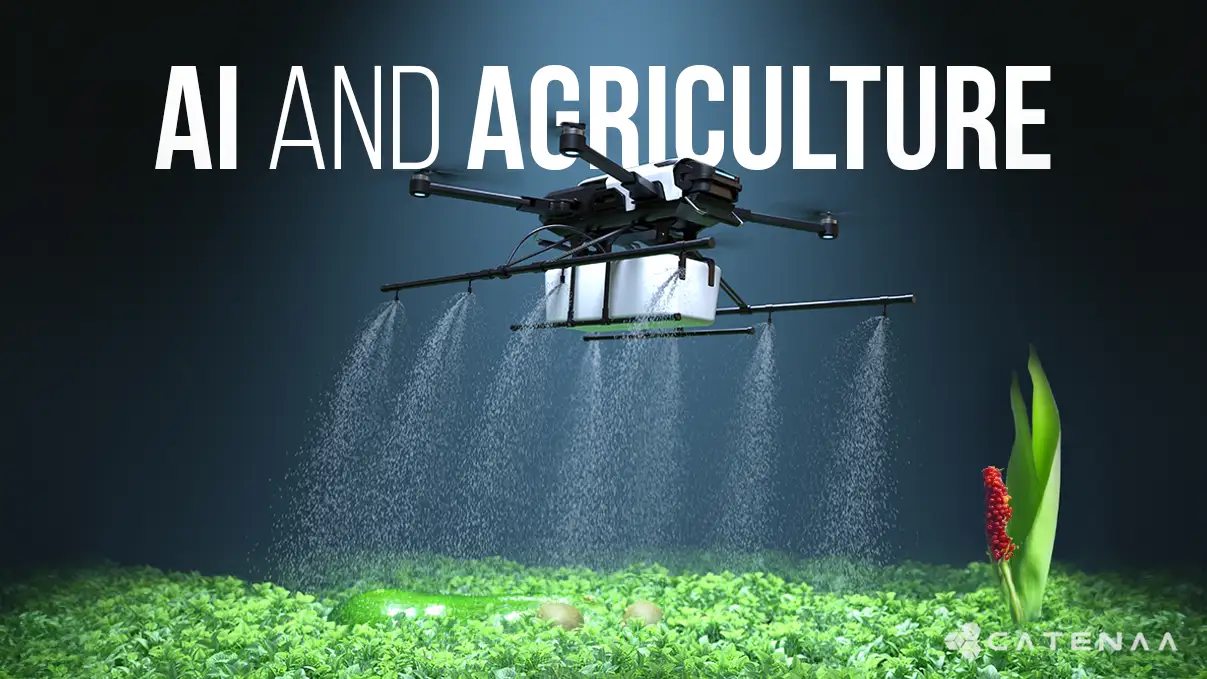Recently, there has been a significant shift in the agricultural landscape due to the incorporation of artificial intelligence into multiple facets of farming activities. AI has become a game-changer with profound effects on food production and sustainability, ranging from precision farming to crop monitoring and yield prediction. AI’s position in agriculture is becoming increasingly important as the world’s population continues to expand and dietary tastes change, driving up demand for food.
The Growth Trajectory of AI in Agriculture
According to the Food and Agriculture Organization (FAO), 60% more food must be produced to feed the 9.3 billion people on the planet by 2050. Given the current industry challenges, this might be difficult to achieve using a farming-as-usual approach. Furthermore, this would increase the already significant burden on our natural resources.1

The trajectory of AI in agriculture is nothing short of remarkable. The market for artificial intelligence in agriculture is expected to expand from $1.7 billion in 2023 to $4.7 billion by 2028, underscoring the critical role that cutting-edge technology plays in this industry.2 This growth is underpinned by the tangible impact of AI applications in enhancing agricultural productivity and sustainability.

1. Precision Farming: Maximizing Yields and Minimizing Inputs
One of the most significant applications of AI in agriculture is precision farming, which involves using advanced technologies to optimize inputs and maximize yields. AI-driven algorithms analyze data from satellite images, sensors, and weather patterns to provide farmers with actionable insights regarding crop health, soil conditions, and water management. By leveraging this data, farmers can make informed decisions about water, fertilizer, and pesticide use, enhancing resource utilization and minimizing waste.

“IBM’s Watson Decision Platform for Agriculture” uses AI to evaluate satellite imagery and meteorological data, allowing for the accurate application of pesticides, fertilizers, and water. To enable higher profitability by delivering more bushels or tons per hectare across common crops, “Watson Decision Platform for Agriculture” provides tailored, low-cost solutions that assist stakeholders across roles in making quicker, more informed agricultural decisions. Second, enhanced sustainability through a deeper understanding of energy usage, land and water use, soil conservation, soil carbon content, and greenhouse gas emissions concerning crop input optimization.
Thirdly, improved quality, as seen in beets’ higher sugar content or barley’s higher protein content. 3
Similarly, Blue River Technology’s “See & Spray” employs computer vision and machine learning in conjunction with controlled spray nozzles to allow for precise herbicide application down to 5cm and to differentiate between crops and weeds. The company claims this can reduce agrochemical use by up to 90%, significantly reducing chemical usage.4
Deep learning algorithms are used by the startup Carbon Robotics in its computer vision system. It uses data analysis from more than 42 high-resolution cameras that continuously scan the fields to identify weeds. Then, it uses lasers and robotics to provide highly accurate weed control. With 99% accuracy, the Laser Weeder can reportedly weed up to two acres in an hour and remove up to 5,000 weeds every minute. Its growers claim to have achieved up to an 80% reduction in weed control costs, with a one- to three-year return on investment.5
2. Crop Monitoring
AI is vital for monitoring crop and soil health and identifying pest infestations, plant illnesses, and nutrient shortages. Using AI-powered drones and sensors, farmers may obtain up-to-date information on crop health and spot irregularities like discolored leaves that could be signs of disease outbreaks or fertilizer shortages. AI-enabled early detection allows for prompt interventions, lowering the chance of crop failure and increasing yields.
Sustainable farming practices and ideal growing conditions depend on continuous soil health monitoring and analysis. Optimizing water use is critical to ensuring crops receive precisely what they need, reducing waste, and enhancing productivity. Soil conditions, such as moisture content, nutrient levels, and pathogen presence, are analyzed using data from in-ground sensors, farm machinery, drones, and satellites. Such soil health analysis helps automate irrigation systems and predicts water requirements.
For instance, using real-time data, CropX has developed a platform specializing in soil health monitoring and enables users to examine and contrast key metrics with crop performance.
To maximize crop management techniques, farmers obtain insights on soil type and vegetation indices such as soil moisture index, soil adjusted vegetation index, and normalized difference vegetation index (NDVI). According to CropX, their solutions have increased output by up to 70% while reducing water and fertilizer usage by 57% and 15%, respectively.6
3. Disease Control
Thanks to AI-driven predictive analytics, farmers can foresee and reduce the risks connected with pest and disease outbreaks. AI algorithms can forecast the spread of diseases and suggest preventive actions by evaluating past data and present patterns. Accurate identification and control of pests is essential to minimize crop damage, ensure farm profitability, and reduce reliance on chemical pesticides.
For instance, Trapview has created a tool that identifies and captures bugs. Pests are drawn to the gadget by pheromones, and a camera captures their images. Utilizing Trapview’s database, AI recognizes more than sixty pest species, including the cotton bollworm that can harm lettuce and tomatoes and the codling moth that attacks apples. Once the insects have been discovered, the algorithm maps out their anticipated impact using location and meteorological data, then notifies the results farmers via an app. These AI-driven insights and timely and focused interventions are made possible, significantly lowering crop losses and chemical use. According to Trapview, its clients have experienced a 5% improvement in output and quality and a total cost reduction to growers of 118 million euros.7
4. Yield Prediction and Optimization
Another area where technology is demonstrating its transformational potential is in AI-powered crop yield prediction. AI systems can accurately predict agricultural yields by evaluating data on plant development, health, and environmental conditions. This allows farmers to make well-informed decisions about planting density, irrigation, and fertilization. With the help of this predictive skill, farmers may increase yields and optimize resource allocation, which boosts sustainability and profitability.8
5. Sustainable Agriculture Practices
The potential of AI to advance sustainable agricultural methods in agriculture may be its most important use, particularly with the growing trend and need for sustainability in the current age. AI helps farmers increase productivity and efficiency while leaving less of an ecological imprint by optimizing inputs, cutting waste, and minimizing environmental effects. AI-based irrigation systems, for instance, can precisely regulate and conserve water by predicting rainfall and analyzing soil moisture levels.
Similarly, AI-driven pesticide and fertilizer applications minimize chemical use, lowering pollution levels and improving soil health.
Looking Towards the Future
With developments like improved precision farming, advanced predictive analytics, robotics and drones, and autonomous machinery primed to further transform farming operations, the potential applications of AI in agriculture are endless. Adopting AI in agriculture is essential for farmers who want to stay sustainable and competitive in a constantly changing world as technology advances.

The application of AI to agriculture signifies a fundamental change in agricultural methods that will significantly impact food security, sustainability, and production. By utilizing artificial intelligence, farmers may take advantage of new opportunities to improve production estimates, optimize resource utilization, and foster environmental stewardship. As a new era in agriculture approaches, farmers who want to prosper in a world that is becoming more complex and interconnected must embrace AI. It is not just a matter of choice.
Graph Citations:
The analysis presented in this article is based on data obtained from the AI Index Report by Stanford University (2024). The data used for the graphs were sourced from this comprehensive report.
- AI in Agriculture: https://www.un.org/en/chronicle/article/feeding-world-sustainably[↩]
- AI in Agriculture: https://www.marketsandmarkets.com/Market-Reports/ai-in-agriculture-market-159957009.html[↩]
- AI in Agriculture: https://www.ibm.com/downloads/cas/ONVXEB2A[↩]
- AI in Agriculture: https://www.soci.org/climate-change-solutions/sustainability/pesticide-dilemma#:~:text=Blue%20River[↩]
- AI in Agriculture: https://carbonrobotics.com/laserweeding-technology[↩]
- AI in Agriculture: https://cropx.com/cropx-system/field-data/[↩]
- AI in Agriculture: https://trapview.com/[↩]
- AI in Agriculture: https://doi.org/10.1016/j.aac.2022.10.001[↩]


